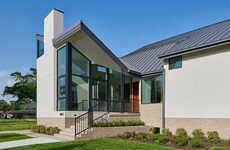
This Cleverly Designed Domed Roof Keeps Homes Cool in Arid Climates
Alyson Wyers — January 10, 2017 — Eco
References: bmdesignstudios & springwise
Designed by Iranian architecture firm BMDesign Studio, the Concave Roof is a double domed roof that collects rainwater to keep homes cool. Perfect in arid countries such as Iran, the roofing system is an environmentally conscious way to keep interiors comfortable in very high temperatures. Consisting of two domes balanced on top of one another, the Concave Roof not only addresses rapid rates of evaporation with its bowl design, it also offers shade below.
The cooling system is an example of how living in an extreme climate can be made more efficient without the use of solar panels.
In the future, BMDesign Studio hopes to alter the domed roof to be suitable for partially submerged structures.
The cooling system is an example of how living in an extreme climate can be made more efficient without the use of solar panels.
In the future, BMDesign Studio hopes to alter the domed roof to be suitable for partially submerged structures.
Trend Themes
1. Rainwater Collection - Incorporating rainwater collection systems in building designs can provide an environmentally conscious way to address water scarcity and reduce reliance on traditional water sources.
2. Climate-responsive Architecture - Designing roofs and buildings that are specifically tailored to extreme climates can greatly enhance the comfort and efficiency of interior spaces, while minimizing the need for additional cooling or heating systems.
3. Innovative Roofing Designs - Exploring unconventional roof designs, such as double domes or concave structures, can offer new opportunities to create energy-efficient and sustainable buildings.
Industry Implications
1. Architecture & Construction - The architecture and construction industry can leverage the trend of inverted roof designs to develop innovative and sustainable building solutions that address climate challenges.
2. Water Management - The water management industry can explore the adoption of rainwater collection systems in order to promote efficient use of water resources and reduce reliance on traditional water sources.
3. Environmental Technology - The environmental technology industry can capitalize on the demand for climate-responsive architecture by developing and providing innovative materials, technologies, and systems that enhance energy efficiency and sustainability in buildings.
6.5
Score
Popularity
Activity
Freshness























